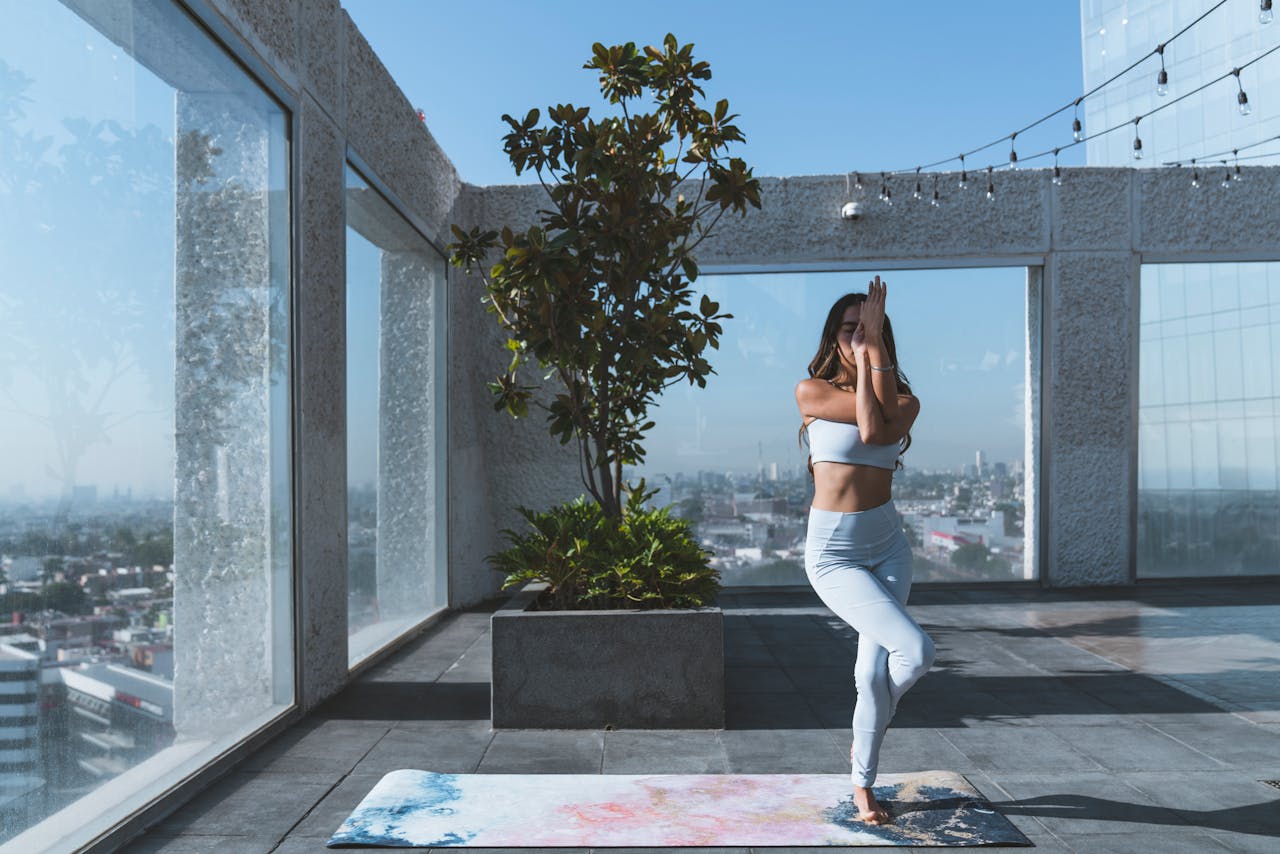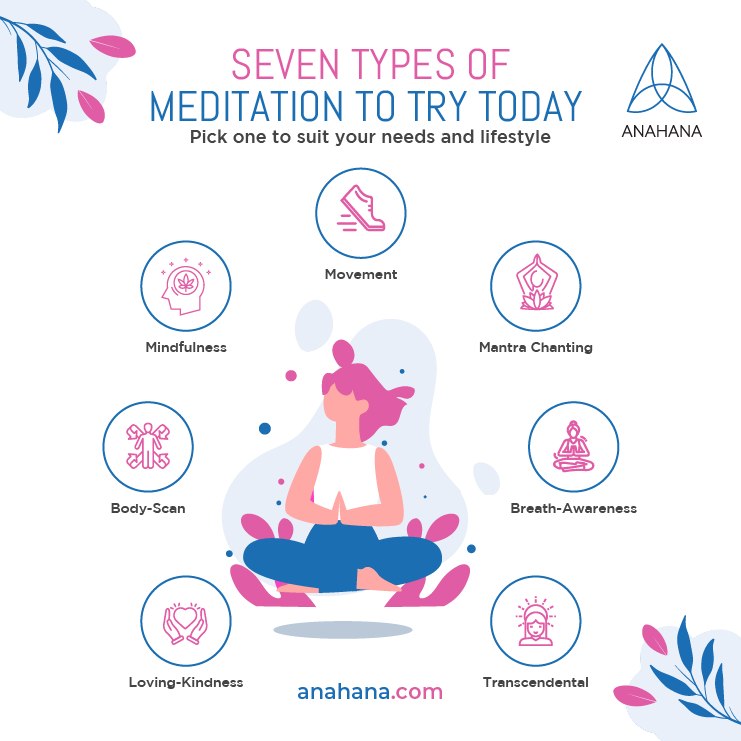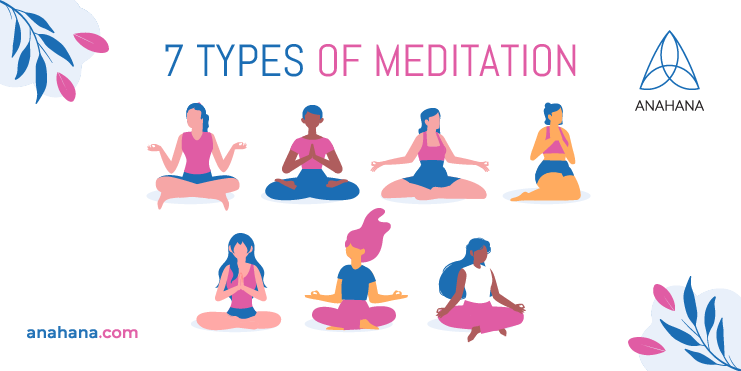
Table of Contents
Discover new meditation techniques to enhance your well-being and inner peace, and start your meditation journey today!
Types of Meditations
Imagine this scenario: You're navigating daily stress with a mountain of tasks to conquer, yet your mind struggles to focus, hindered by mental fatigue. Does this situation resonate with you?
Contrary to the misconception of meditation being simply ‘sitting and thinking about nothing, ’ meditation practice is meant to be a method of being aware of your present moment and offers a reprieve from your daily rush.
Allocating time for yourself allows you to return to your life and responsibilities rejuvenated, enhancing both your mental and physical health.
When it comes to a one-size-fits-all approach to meditation, it's actually about discovering what aligns best with your unique needs and goals. Many meditation practices vary in techniques, intentions, and benefits.
This article will outline seven of the many types of meditation techniques.
Types of Meditations

Many types of meditation can help you achieve your health goals.
One thing to consider is the difference between internal and external awareness in meditation.
Internal awareness involves paying attention to your thoughts, emotions, bodily sensations, and mental processes, while external awareness involves being aware of the environment, sensory experiences, and external stimuli.
It’s suggested that both types of awareness are important and valuable and can complement each other in meditation practice. Internal awareness helps you understand your inner experiences and cultivate self-awareness, emotional regulation, and introspective insight.
If you struggle with that, it may be most beneficial to you. Conversely, external awareness can help you stay grounded in the present moment, reduce rumination, and cultivate a connection to the world around you. For some people, that is an easier place to start.
Seven Ways to Practice Meditation
The following are some of the most common ways to meditate that many people find helpful.
Mindfulness Meditation
Mindfulness meditation originates from ancient traditions and teachings in Buddhism.
Mindfulness meditation focuses on the present rather than memories of the past or future uncertainties.
Practicing mindfulness meditation combines aspects of concentration, patience, and heightened awareness.
In this practice, you gently observe your surroundings and allow thoughts to drift by without getting entangled in them.
In mindfulness meditation, people usually bring their attentional focus to their breathing.
You can easily practice mindfulness meditation anytime and anywhere, whether alone or in the company of others. Find a comfortable seat, and you're ready to begin.
And you will find that many different types of meditation have a root element of mindful meditation.
Body-Scan Meditation
Body-scan meditation is a technique that encourages you to take note of feeling every part of your body sequentially, creating a sense of inner connectedness and wholeness. It can also be practiced as a progressive relaxation; this meditation brings awareness to the tensions in your body so that you can release them.
You could participate in three main ways:
-
The first way is to start with one end of the body and think through all the body parts until they are completely relaxed. You can tell yourself, “I am relaxing my toes,” and so on.
-
The second way to practice is to intentionally practice physical relaxation by tightening and releasing a muscle group slowly, one at a time.
-
The third way is to imagine a wave gently drifting through yourself to help relieve tension and blockages between separate areas.
This type of meditation is most often used before sleeping to unwind at bedtime.
Focusing on your bodily sensations might feel challenging initially, but the more you practice, the more attentive and aware you become of your body and what it’s trying to tell you.
Loving-Kindness Meditation
Loving-kindness meditation aims to strengthen positive emotions, such as compassion and acceptance, within yourself and others—hence the name loving-kindness meditation.
While taking deep breaths, you would open your mind and heart to receive feelings of loving kindness from others or the universe and, in turn, send out similar messages to loved ones, friends, specific beings, or the whole world.
Loving-kindness meditation, which fosters positive energy, is well-suited if you’re looking to release anger, shame, resentment, frustration, or negativity.
Transcendental Meditation
Transcendental meditation involves being seated and breathing slowly; as the name implies, it aims to transcend your current state.
You will focus on a repeated mantra—a single word or series of words—as they participate in a session. This is practiced for 15-20 minutes twice a day.
It is recommended to have a certified meditation teacher be involved in choosing your mantra and helping you work through your meditation so that your session can be fully personalized and provide the best results for yourself.
It would suit those who want to explore a deeper connection to awareness and consciousness than mindfulness meditation alone.
Breath-Awareness Meditation
This meditation technique encourages mindful breathing; while it contains elements of mindfulness meditation, there is a slight difference in the finer details between the two practices.
Where mindfulness meditation would have involved letting your thoughts come in and out of your mind freely, breath-awareness focuses entirely on the experience of breathing and releases all other ideas that enter your consciousness.
Counting breaths is an option to help focus but is not required. Since it is an offshoot of mindfulness meditation, breath-awareness meditation's benefits are much the same for any potential practitioner.
Mantra Meditation
Mantra meditation is prominent in many teachings, such as Hindu traditions and Buddhist practices. Repeat a sound out loud to clear the mind; it can be a sound, a word, or a phrase.
One of the most common is “om.” This repetitive sound becomes your mantra and can be spoken loudly or quietly.
After chanting the mantra for a while, you’ll find yourself more in tune with your environment and become more alert to your surroundings, thus allowing you to achieve a deeper understanding of the present moment.
Mantra meditation can be enjoyed by those who find it easier to focus on a word or sound than their breath or enjoy the vibration it creates in their body. It is also suited for those who don’t like silence and enjoy repetition.
Movement Meditation
Where most meditation techniques will ask you to be still and sit quietly, movement meditation focuses on your body in motion.
Activities in this meditation practice may include mindful walking, yoga, tai chi, martial arts, and many more.
Being more committed to physical sensations can be very beneficial; like mantra meditation, this practice utilizes repetition to deepen awareness of your body and the present moment.
When you are ready to take it further, your consciousness can include any motion: gardening, showering, etc. This best suits those who concentrate better or have trouble staying still.
In addition to all types listed above, there are a couple of other meditation styles to consider as a way of reaching inner harmony or even achieving spiritual growth:
-
Metta meditation
-
Vipassana meditation
-
Qigong meditation
-
Insight meditation
- Spiritual meditation
Meditation, as a whole, can be very beneficial for your body and mind, and not just to relieve stress.
Studies have also linked meditation to better sleep, reduced anxiety, lower blood pressure or chronic pain, and improved physical and mental health in everyday life.
Although we have only listed seven types of meditation here, many techniques and practices have similar elements or entirely different meditation types.
There is no correct answer to ‘what is the best type of meditation’ because many meditation types work towards bettering yourself in various capacities and cannot be thoroughly compared. The best way to start is to find a comfortable position and begin.
What are the Benefits of Meditation?

There are many benefits of meditation practice, both physical and mental, and it’s essential to recognize that once you begin to work towards a consistent practice, it will positively impact multiple areas of your life. Meditation offers valuable tools for enhancing mental and emotional health, whether seeking stress reduction, improved focus, emotional resilience, or overall well-being.
Meditation can improve your well-being if you’ve been experiencing issues with sleep, anxiety disorder, chronic fatigue, or chronic pain.
Meditation can help to:
-
Reduce stress
-
Tackle chronic pain
-
Improve concentration
-
Increase self-awareness and self-esteem
How to Get Started with Meditation
To get started with meditation, choose which types of meditation you would like to try. The key is to find a meditation practice that aligns with your goals.
You can research types of meditation, watch guided meditation videos or talk to professionals to narrow down your choices.
Once you have chosen the type of meditation you want to try, find a quiet and comfortable space where you won't be disturbed. Set aside a few minutes each day to practice, gradually extending the duration as you become more comfortable.
Be patient with yourself throughout this process, as progress with meditation can take time. It is helpful to make meditation part of your daily routine so that it becomes a daily habit.
Frequently Asked Questions About Types of Meditation
How can I choose the best meditation technique for myself?
Selecting the proper meditation technique involves considering your goals and preferences.
Explore different methods and determine which resonates with your needs, lifestyle, and values.
Experimenting and seeking guidance from experienced practitioners or instructors can also help you find the most suitable approach.
What are the best meditation practices for sleep?
Effective meditation practices for sleep include mindfulness, which calms the mind, and body scan meditation, which promotes physical relaxation.
Yoga Nidra induces deep relaxation, loving-kindness meditation reduces stress, and progressive muscle relaxation eases tension. The best choice depends on individual preferences and needs.
Is there a yoga meditation?
Yes, there is a form of meditation called yoga meditation. It integrates the physical postures of yoga (asanas) with mindfulness, breathwork, and specific meditation practices.
Yoga meditation aims to unite the body, mind, and spirit, promoting holistic well-being, self-awareness, and spiritual enlightenment.
References
What Is Meditation? Proposing an Empirically Derived Classification System - PMC
Harvard researchers study how mindfulness may change the brain in depressed patients
7 Guided Meditations for Uncertain Times - The New York Times
The stress secret: 12 ways to meditate – without actually meditating
Mindfulness meditation: A research-proven way to reduce stress
Disclaimer
The contents of this article are provided for informational purposes only and are not intended to substitute for professional medical advice, diagnosis, or treatment. It is always recommended to consult with a qualified healthcare provider before making any health-related changes or if you have any questions or concerns about your health. Anahana is not liable for any errors, omissions, or consequences that may occur from using the information provided.

By: Meriah McCauley
Meriah McCauley is a leading voice in holistic healing, known across North America for her expertise in chakra balancing, spiritual alignment, and energy-based wellness. Her work bridges the art and science of mind-body healing, shaped through years of study, practice, and mentorship. Meriah deepened her understanding of spiritual anatomy and the chakra system under the guidance of her guru, Dr. Don Stapleton, during her immersive training in Costa Rica. She later earned her Master’s degree in Psychology from Columbia University, specializing in Spirituality and the Mind–Body connection, which continues to influence her integrative approach. Today, she supports individuals and practitioners through coaching, yoga teacher trainings, chakra-focused education, and Holotropic Breathwork for personal transformation. Meriah is dedicated to helping others develop emotional clarity, energetic balance, and spiritual resilience—and she remains committed to guiding anyone seeking a deeper, more meaningful connection with themselves.